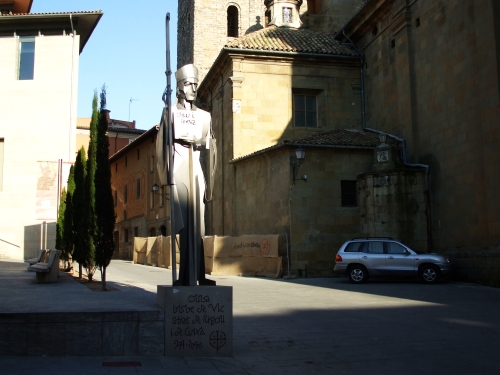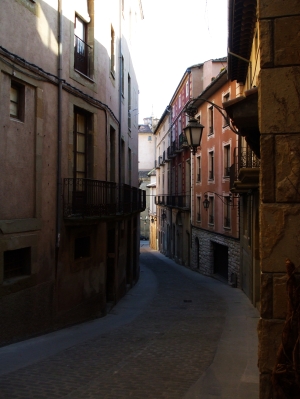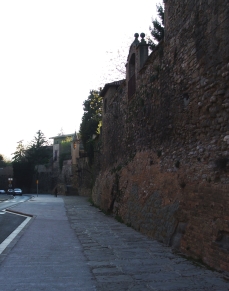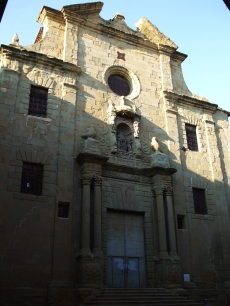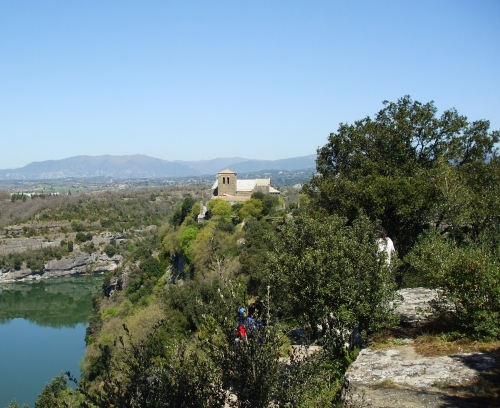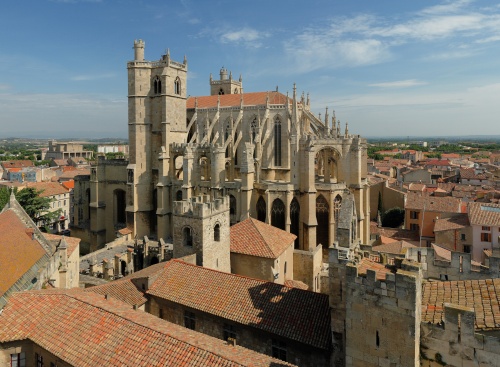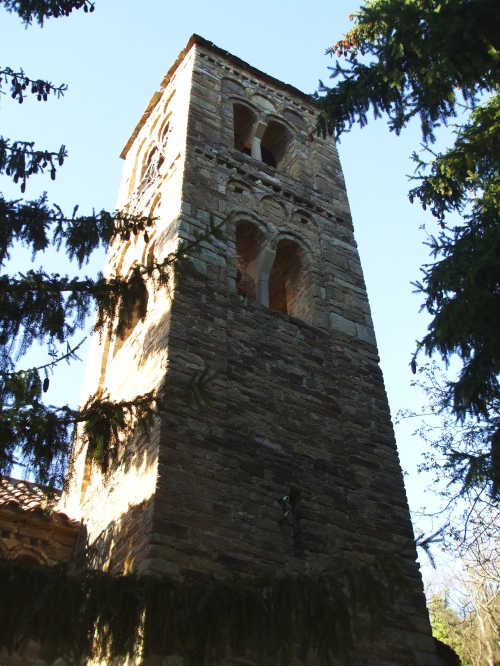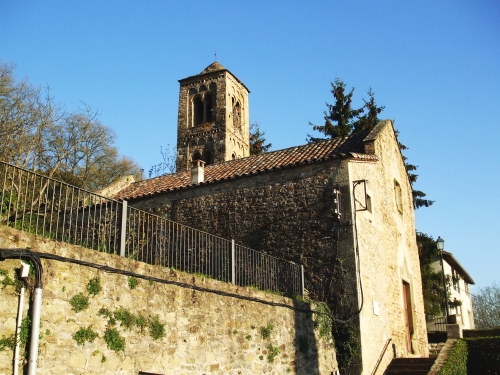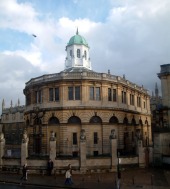
Well, no, hang on, I am inclined to do that, no subjunctive necessary. I do it about the salt trade and about aristocrats and I do it more or less in sport, because ultimately Chris has read about two hundred times more than I have and just has a better basis for being right about what he says than I do except on a very few topics. But, if while chomping avidly through Framing The Early Middle Ages I had stumbled on such things where I know enough to wonder about alternatives, you understand, and had thought about it a bit and still not quite resolved them, they would be these.
Supply and Demand
This has been on my mind a bit lately because of arguing with both Guy Halsall and Chris about the effect of climate change on the medieval economy. I, seeing as has Fredric Cheyette (so I have good company) that the new climate data on the Medieval Climatic Anomaly makes the rise in temperature up to and beyond the year 1000 ever more evident, have assumed that this must have meant more surplus, thus more resource for those able to appropriate surplus, and thus simultaneously more options on how to spend for those people and also more competition for them, as suddenly extra people can get into the game. I actually think this still floats, but there is an important point which Chris’s work should have warned me about, that being that this surplus only grows if someone wants it; otherwise, as Chris has legendarily put it, the peasants would just eat more and work less.1 I think we could find entrepreneurial peasants, here and there, but the point needs defending at least. I have been thinking purely in terms of supply; Chris, arguably, has considered demand far far more important.

Roman-period olive press at Capernaum, Israel (from Wikimedia Commons)
Now, Chris puts quite a lot of weight in Framing on the breakdown of economic systems based on the Roman market economy; with no supply, the demand for either basic substances (or, if you’re instead Guy Halsall, for example, and consider luxury trade anything more than marginal, luxuries that you as local leader deploy to maintain your position) can’t be met, and anyone with importance who wants to keep it has to reconfigure it hugely.2 The collapse, for both Chris and Guy, is supply-driven. On the other hand, when the economy recovers and complex polities are built again, it’s not because of a change in supply, for Chris, it’s because the polities themselves drive the economy. He can do this without being inconsistent because for him the Roman economy was also driven by the state, so the supply that collapses was created by a previous demand, and I see the point but nonetheless there’s a chicken-and-egg problem at the recovery end of the process; do the aristocrats see that the land could grow more, and work out how to make peasants do that, or do they see rich peasants and think, how can I use that? Surely the latter, since Chris himself argues that agronomy was not the pursuit of more than a slightly odd subset of the Roman élite.3 So, surely that’s supply-led not demand-led. I think there may be scope for argument here.
Warleadership as a non-material resource
More briefly, because it implicates less of my own thinking: in Chapter 6 of Framing, Chris discusses the resources available to rulers of a ‘tribal’ polity, or rather, of tribal polities in the process of becoming what he terms states.4 (Magistra has covered all this terminology-chopping, which is necessary and substantive but which I don’t want to repeat, better than I am therefore going to.) These include trade tolls, for some, tribute of course, a marginal amount of judicial income and revenue from landownership. He also mentions booty taken in war but thinks this too is marginal. Well, OK, yes, it probably is, but there was something important about being able to get hundreds of men to come on campaign with you anyway, especially if they fed themselves; one could even say that since they were then using their surplus to your greater cause, this is a material income, but I’m more interested in the non-material side, the authority that ruler could claim and deploy. I think this is important because it distinguishes between polities that Chris classes as similar, Wales, Ireland, Norway or Frisia, Denmark and the non-Mercian English kingdoms. It’s always hard to measure army sizes, we know this (again it is useful to put Chris and Guy together here, as they are once again mostly in agreement but interested in different things), but Norway seems to have had quite a lot of its population militarised at some points, and sometimes Wales could raise armies that can take on Northumbria, and then ever after it could not.5 Frisia didn’t really have any army at all that we know of; that seems to be something its kings didn’t get to do, perhaps because wealth was so distributed there via trade. Denmark absolutely did, however. And I would also add in the Picts, and in fact any militarised group from outside the Empire; they didn’t have much political complexity, they may not even have had any kind of stable rulership, but they could raise enough men in arms to take on the Roman Empire’s local manifestations. I don’t think this was economically important, myself, but I think that a king who could lead an army of maybe a thousand or even five thousand men in times of real need, and even more so if not times of real need, was playing in a different league than one who could raise, well, 300 heroes after a year’s feasting, especially if those two then face off against each other. He could do more things. He could probably build dykes and so on, but he could also defend larger areas (because he presumably called troops from them). It’s not negligible just because he didn’t increase his personal resources from it. (And after all, the Carolingians found a way to turn that obligation into money.6) That’s an argument I could have, too.
Breakdown and Build-up in Britain
The sections of Framing on sub-Roman Britain are probably the most provocative bits, because it is certainly true that often the outsider sees most of the game; few people are better-placed than Chris to spot what looks odd and, well, insular, about a national scholarship.7 Using this perspective as leverage, he argues for a rapid and almost total breakdown of political organisation in Britain, down to tiny levels, 100-hide and 300-hide units, that then recombine. I am fine with this for the becoming-English lowlands, and Chris argues therefore that British polities there must have been equally tiny or the English could have never got established, and that by extension this must apply to the more outlying British polities. I don’t like this quite so well. The outlying ones, profiting from the fact that they still had a Roman-facing seaboard in some sense, were for a while richer than the lowland zones, most would agree; Tintagel and Dinas Powys and Dumbarton may have been tiny-grade compared to a Continental aristocracy, but in their context they were major players (Dinas less so, but stay with me).8 Surely these should have started large (if not sophisticated) and broken down, not collapsed into fragments and been reassembled? They were far enough from the eastern seaboard that changes there and next-door to Neustria would be beyond their reach, but the same is also true in reverse, the tiny polities of the incipient North Sea zone are far from the Atlantic trade-routes and the polities that profit from them. It’s only once the English kingdoms had built up a bit, at which point they had the North Sea working for them and could thus start to become rich themselves while the Mediterranean links were finally dying out for the British, that the once-big-kingdoms of the now-Welsh were directly opposed to the English.9 Once that began, too, it’s not clear in all cases that the English were superior; Urien of Rheged managed to pen the king of Bernicia up on an island off the coast, for example, that Anglian kingdom effectively reduced briefly to a few acres. Bernicia was no match for the hegemony Rheged briefly had. Was it a stable unit, no, but neither was Bernicia. Rheged there marched with several other kingdoms, so there was assemblage going on, but do the blocks here have to have been tiny? It retained a bishopric, after all.10 I see no need for the tiny-then-bigger pattern to be true for the whole island.
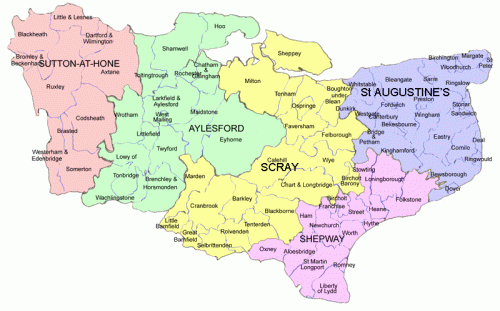
Map of the lathes and hundreds of Kent; note the big divisions west versus the small chopped-up ones east
I would go further, and say that one model won’t do here anyway, even in the lowland zones. Every piece of local comparative work that gets done in England seems to stress variation. East Kent did not form like West Kent; one hundred in Suffolk is not like another… it goes on and on.11 Some of these places do seem to see new settlement that becomes determinant of their identity, but we can think of other ways too. The written sources even nudge at them a little bit. Mostly the Anglo-Saxon Chronicle says that such and such a royal line arrived in three ships and defeated the Britons who resisted their arrival at a place that’s now named after them. This is self-evidently a trope but it at least tells us that the royal line later on had a tradition that they’d come from outside. The sources, such as they are, don’t do this for Bernicia, just saying that Ida took the kingdom, and I’m not the first person to use this and the archæology to suggest that Bernicia, which after all is an Anglian kingdom with a Celtic name, was more of a takeover by its own military (who presumably identified as Anglians, however many things that might actually have meant in terms of extraction or origin) than a settlement.12 Not exactly lowland, you may say, and fair enough but there are similar things that can be said about London and maybe Lincoln. With Lincoln it’s just an argument based on a series of kings of Lindsey with apparently-British names but with London, where there is confusing archæology and no textual evidence of any kind between 457 and 600, the argument is based on a ring of early place-names, all at places that were never very large (Braughing, Bengeo, Mimms, Yeading, Tottenham, Twickenham, Ealing, Harrow and so on), more or less circling the town, which the person who was making this argument, Keith Bailey, suggested might show an orchestrated establishment of settlers as a kind of perimeter defence. That then implies some unit of a considerable size, presumably centred on the old Roman city, but then so does the term Middlesex, which was already not a kingdom or a recognisable people (at least not one that Bede thought worth mentioning) by 600, because by then London was in Essex and the King of Kent held property in it.13 But it obviously had been, or there’d be no name.
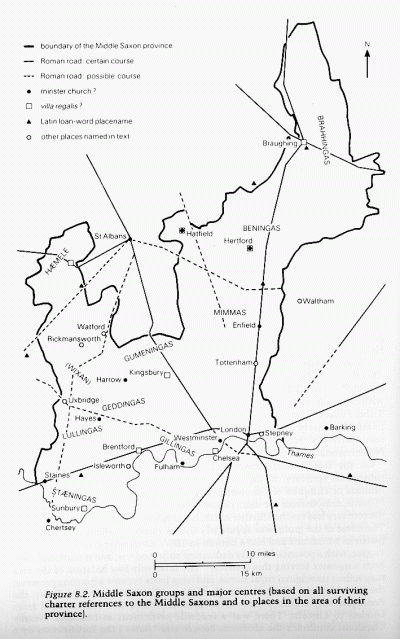
Early settlements around London in the Anglo-Saxon period, from Keith Bailey's "The Middle Angles"
So, in this paradigm, small-scale settlement and large political units might go together, albeit, I will admit, not for very long. But that’s what I’m talking about: British breakdown and Anglo-Saxon build-up at the same time. I use those ethnicity terms as if they meant something, but with this kind of process going on I doubt any outsider would have been able to tell the difference between British and English in areas like this; it would be a political affiliation, based perhaps on what king you did military service for, something which you might be able to change a few times if you were clever. I suspect that concern with ethnicity and origins was more of an issue for the leaders, who would need it to justify their position, than the rank and file, until one such ethnicity became clearly dominant in an area and it was necessary to belong. Anyway: this is anything but socio-economic analysis, I realise, and perhaps to make such comment is only to recognise that Chris wasn’t, despite the size of the book, trying to solve the entire problem of the Transformation of the Roman World (as you might call it) in one go. He also invites the reader to consider, before really getting going, whether any quarrels they might have would damage the argument of the book.14 I don’t pretend that I’ve raised any such issues (and if I thought I had such issues to raise, I wouldn’t do it via blog-posts). It’s just some extra possibilities that might add a few spots of seasoning to a thoroughly nourishing book. Some dessert will follow in another post.
1. In his “Problems of Comparing Rural Societies in Early Medieval Western Europe” in Transactions of the Royal Historical Society, 6th Series Vol. 2 (Cambridge 1992), pp. 221-246, rev. in idem, Land and Power: studies in Italian and European social history, 400-1200 (London 1994), pp. 201-226, at p. 224 of the reprint.
2. Wickham, Framing the Early Middle Ages: Europe and the Mediterranean, 400-800 (Oxford 2005), pp. 72-80 but also passim; as with any comparative work this one is difficult to cite well because the same themes come up again and again. A clearer statement of this point could be found in Wickham, “Marx, Sherlock Holmes, and Late Roman Commerce” in Journal of Roman Studies Vol. 78 (London 1988), pp. 182-193, rev. in idem, Land and Power, pp. 77-98. Cf. Guy Halsall, Barbarian Migrations and the Roman West, 376-568, Cambridge Medieval Textbooks (Cambridge 2007), pp. 112-137 & esp. p. 124.
3. Wickham, Framing the Early Middle Ages, pp. 268-272.
4. Ibid., pp. 303-379, definitions addressed at pp. 303-306.
5. Here the Halsall comparison would better come from Guy Halsall, Warfare and Society in the Barnarian West 450-900 (London 2003), pp. 119-133. For Norway I’m thinking of the First Viking Age (classically described in Peter Sawyer, The Age of the Vikings, 2nd edn. (London 1971)) and for Wales I’m thinking of when King Cædwallon of Gwynedd killed King Edwin of Northumbria in 633.
6. Described very well, albeit with the ideological bent you’d expect from sixties East Berlin scholarship (or rather, that the establishment demanded from it) in Eckhard M¨ller-Mertens, Karl der Grosse, Ludwig der Fromme, und die Freien. Wer waren die Liberi Homines der Karolingischen Kapitularien (742/743-832)? Ein Beitrag zur Sozialgeschichte und Sozialpolitik des Frankenreiches, Forschungen zur Mittelalterlichen Geschichte 10 (Berlin 1963).
7. Wickham, Framing the Early Middle Ages, pp. 306-333 & 339-364 (to which cf. Halsall, Barbarian Migrations, pp. 311-319 & 357-368); see also the sweeping but careful description of national historiographies in Wickham, Framing the Early Middle Ages, pp. 1-5.
8. Halsall as above and Leslie Alcock, Kings & Warriors, Craftsmen & Priests in Northern Britain AD 550-850, Society of Antiquaries of Scotland Monographs (Edinburgh 2003), pp. 83-93.
9. Richard Hodges, “King Arthur’s Britain and the End of the Western Roman Empire” in idem, Goodbye to the Vikings? Re-Reading Early Medieval Archaeology (London 2006), pp. 28-38.
10. M. R. McCarthy, “Thomas, Chadwick and post-Roman Carlisle” in Susan M. Pearce (ed.), The Early Church in Western Britain and Ireland: studies presented to C. A. Ralegh Radford arising from a conference organised in his honour by the Devon Archaeological Society and Exeter City Museum, British Archaeological Reports (British Series) 102 (Oxford 1982), pp. 241-256.
11. Kent: Nicholas Brooks, “The Creation and Early Structure of the Kingdom of Kent” in Stephen Bassett (ed.), The Origins of Anglo-Saxon Kingdoms (Leicester 1989), pp. 56-74 esp. pp. 67-74, and now Stuart Brookes, “The lathes of Kent: a review of the evidence” in Brookes, S. Harrington and Andrew Reynolds (edd.), Studies in Early Anglo-Saxon Art and Archaeology: Papers in Honour of Martin G. Welch, British Archaeological Reports (British Series) 527 (Oxford 2011), pp. 156-170 (non vidi, but I saw a Leeds paper using some of what I assume is the same research that pointed this way). Suffolk: Peter Warner, “Pre-Conquest Territorial and Administrative Organization in East Suffolk” in Della Hooke (ed.), Anglo-Saxon Settlements (Oxford 1988), pp. 9-34.
12. That person, as far as I know, would be Brian Hope-Taylor in his Yeavering: an Anglo-British Centre of early Northumbria (London 1977), pp. 276-324; cf. David N. Dumville, “The origins of Northumbria: some aspects of the British background” in Bassett, Origins of Anglo-Saxon Kingdoms, pp. 213-222.
13. London’s archæology is ever-changing but the best recent synthesis I know is Alan Vince, Saxon London: an archaeological investigation (London 1990). This argument, however, and the following graphic, are more or less lifted entire from Keith Bailey, “The Middle Saxons”, in Bassett, Origins of Anglo-Saxon Kingdoms, pp. 108-122, the map being fig. 8.2. I’m slightly disturbed to see that his cite for the idea of orchestrated settlement is John Morris, to wit Londonium: London in the Roman Empire (London 1982, rev. edn. 1998), p. 334 of the 1st edn., cit. Bailey. “Middle Saxons”, pp. 112-113 n. 52, but despite Morris’s well-known oddity this seems to be a bit that makes sense, to me. On Lindsey, since you already have the volume out by now, see Bruce Eagles, “Lindsey” in Bassett, Origins of Anglo-Saxon Kingdoms, pp. 202-212.
14. Wickham, Framing the Early Middle Ages, p. 9.
51.752448
-1.255184
